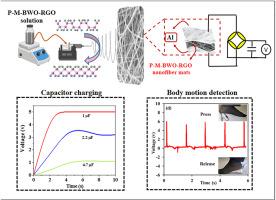Development of an efficient, lead-free piezoelectric nanogenerator utilizing PVDF: MnO2–Bi2WO6: RGO composite fiber for self-powered sensing and biomechanical energy harvesting
IF 4.3
3区 材料科学
Q2 MATERIALS SCIENCE, MULTIDISCIPLINARY
引用次数: 0
Abstract
In this study, we have fabricated a highly efficient, environmentally safe, and flexible piezoelectric nanogenerator (PENG) utilizing a composite material comprising manganese oxide-bismuth tungstate (MnO2–Bi2WO6), polyvinylidene fluoride (PVDF), and reduced graphene oxide (RGO) by an optimized electrospinning technique. The PENG constructed with aluminum-based electrodes demonstrates an open-circuit voltage of 5 V and a short-circuit current of 2 μA under the influence of a compressive force measuring 10 N at a frequency of 3 Hz. These measurements were 3.2 and 3.3 times higher, respectively, than those of the original PVDF PENG. Moreover, the optimized PENG achieved an instantaneous power density of 0.4 mW. The exceptional performance of the nanogenerator can be ascribed to the synergistic blend of the β-phase PVDF polymer, the non-centrosymmetric characteristics of MnO2–Bi2WO6 nanosheets, and the electrical conductivity provided by RGO. Additionally, to evaluate both its capacity for sensing and energy harvesting capabilities, the fabricated PENG was utilized for detecting diverse human movements and charging multiple capacitors. Observations revealed that mechanical stimulation could charge a capacitor with a capacity of 1 μF–5 V within 2.4 s, suggesting a viable platform for removing the requirement of an external power source for operating portable devices. As a result, the created PENG exhibits considerable promise and can serve as a viable substitute for traditional power sources in self-sustaining devices, providing its stability and flexibility.

利用 PVDF 开发高效无铅压电纳米发电机:用于自供电传感和生物力学能量采集的 MnO2-Bi2WO6: RGO 复合纤维
在这项研究中,我们利用由氧化锰-钨酸铋 (MnO2-Bi2WO6)、聚偏二氟乙烯 (PVDF) 和还原氧化石墨烯 (RGO) 组成的复合材料,通过优化的电纺丝技术制造出了一种高效、环保、灵活的压电纳米发电机 (PENG)。使用铝基电极构建的 PENG 在频率为 3 Hz 的 10 N 压缩力的影响下,开路电压为 5 V,短路电流为 2 μA。这些测量结果分别是原始 PVDF PENG 的 3.2 倍和 3.3 倍。此外,优化后的 PENG 的瞬时功率密度达到了 0.4 mW。该纳米发电机的优异性能可归功于β相 PVDF 聚合物、MnO2-Bi2WO6 纳米片的非中心对称特性以及 RGO 提供的导电性的协同混合。此外,为了评估 PENG 的传感能力和能量收集能力,制作的 PENG 被用于检测各种人体运动并为多个电容器充电。观察结果表明,机械刺激可在 2.4 秒内为一个容量为 1 μF-5 V 的电容器充电,这表明这是一个可行的平台,无需外接电源即可操作便携式设备。因此,所创造的 PENG 具有相当大的前景,可作为自持设备中传统电源的可行替代品,具有稳定性和灵活性。
本文章由计算机程序翻译,如有差异,请以英文原文为准。
求助全文
约1分钟内获得全文
求助全文
来源期刊

Materials Chemistry and Physics
工程技术-材料科学:综合
CiteScore
8.70
自引率
4.30%
发文量
1515
审稿时长
69 days
期刊介绍:
Materials Chemistry and Physics is devoted to short communications, full-length research papers and feature articles on interrelationships among structure, properties, processing and performance of materials. The Editors welcome manuscripts on thin films, surface and interface science, materials degradation and reliability, metallurgy, semiconductors and optoelectronic materials, fine ceramics, magnetics, superconductors, specialty polymers, nano-materials and composite materials.
 求助内容:
求助内容: 应助结果提醒方式:
应助结果提醒方式:


